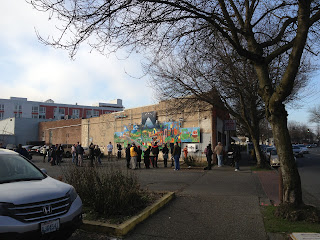------Isaiah
Berg, Jun Li
*Photos are taken on January 19, 2013
Our
photo essay examines the way public and private space is used in the
International District and Columbia City. We interpret a ‘Shared City” as
blurring between public and private domains.
Photo1
shows police descend on a private Chinese association gathering in China town
foreground. In Photo 2-3, the private
event is permitted to shut-down the public street temporarily because the
Chinese association showcases Kung Fu for elders and visitors.
Photo4
show the public sidewalk in the International District is occupied by local
merchants to sell mixed vegetables. And such phenomenon is very common and has
existed for many years.
*Photo1-4 are taken in King
Street, International District, Seattle, WA 98104
Our next
location was in Columbia City from south Seattle.
In Photo
5-6 we can see how private space is used publicly. A mural is unveiled after 18
months of work. The mural attracts a dozen
people, initially artists and their friends came, but as the crowd grows, larger
audiences from the neighborhood follow to be attracted by the mural.
Neighborhood
non-profit groups and community organizations helped to fund this mural project;
they receive a sort of advertising acknowledgement on the mural. The building
and parking lot on the pictures are privately owned, but clearly benefit the
public.
The
mural displays the past, present and utopian future of Columbia city.
Photo7 is
part of the mural, it highlights the cultural diversity of Columbia city and
adverts such value to the public in this private place.
As Photo8
shows, the benefit is blurred. This private nearby shop gains business from the
increased foot traffic. This privately-own mural benefits the nearby commerce,
it as well helps to brand Columbia city for its culture and value, thus
mutually benefiting both public and private interests.
*Photo5-8 are taken in
Columbia City Seattle WA 98118
We often
think about urban space as either public or private, but this binary does not
explain the reality of urban living. Often public space is used by private
organizations, and increasingly private space is used for the public good. The
“Shared City” should welcome everyone to be engaged and interact with each
other (diverse classes, genders, and ages), no matter the place inside belongs
to public or private.









No comments:
Post a Comment